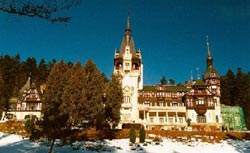| Hunting | |
| Adventure | |
| History | |
| Environment | |
| Getting Around | |
| When to Go | |
| Travels | |
| Attractions | |
| Travel Stories | |
| Our offer | |
| Contact us | |
 |
|
| Transylvania | Brasov | Bran | Scornicesti | Bucharest |
| Black Sea | Danube Delta | Fagaras | Sinaia | Bucovina |
| Maramures | Sighisoara | Iasi | Cluj-Napoca | Timisoara |
|
 |
|||
The town's train station is a historical site in itself; here the Iron Guard murdered the Liberal leader Ion Duca in 1933, only three weeks after he had taken office as prime minister. Steps lead up from the station to a small park containing a casino, a museum dedicated to the natural history of the Bucegi mountains, and two turn-of-the-twentieth-century hotels, the Palace and the Caraiman - both fine neo-Brâncovenesc buildings. Beyond the park, Strada Manastirii leads up to Sinaia Monastery (open during daylight hours), built by the boyar Michael Cantacuzino in 1690-95 on the site of an earlier hermitage, and so called because it contained a stone he had brought from Mount Sinai. The original church is not the one before you as you enter (which was built in 1842-46), but hides through a passageway to the left. Just behind the monastery, a road leads up to one of the most popular destinations in Romania, Peles Castle (Wed-Sun 9am-5pm;). Set in a large park, which is landscaped in the English fashion, the castle outwardly resembles a Bavarian Schloss. It was built between 1875 and 1883 for Romania's imported Hohenzollern monarch, Carol I, and largely decorated by his eccentric wife Elisabeta (better known as the popular novelist Carmen Sylva, the "Romanian Sappho"), who once decreed that court life at Sinaia be conducted in folk costume. Peles contains 106 rooms, richly decorated in ebony, mother of pearl, walnut and leather - all totally alien to the traditional styles of Romanian art. There are almost eight hundred stained-glass windows in the building, whose rooms are stuffed solid with Persian carpets, Renaissance weapons, Murano chandeliers, and copies of the Rembrandts and other paintings now housed in Bucharest's National Art Museum. One Louis XIV room (with pre-Raphaelite paintings) houses Romania's first cinema. How a man of such reputedly austere tastes as Carol managed to live here is something of a mystery. Following the monarchy's demise in 1947, Peles was opened to the public, with a temporary interruption when the Ceausescus appropriated it as a "state palace". The Ceausescus actually preferred to stay in the Pelisor Palace (Little Peles; Wed-Sun 9.30am-5pm;), a few hundred metres up the hill, built in 1899-1903 for Ferdinand and Marie, Carol I's heirs. Although its exterior is also in the German Renaissance style, the interior is Art Nouveau, with Viennese furniture and Tiffany and Lalique vases, and is much more to the taste of Western visitors. Foisor Lodge , a little above Pelisor, was the home of Prince Carol (later crowned Carol II) and Princess Helen from 1921; here Carol met the Jewish Magda Lupescu, who remained his mistress for thirty years and became the power behind the throne, outraging Romanian society, which tended towards anti-Semitism. Foisor park is open to the public (Wed-Sun 9am-4pm), but the lodge, another former summer residence of the Ceausescus, is still reserved for government entertaining. |
||||